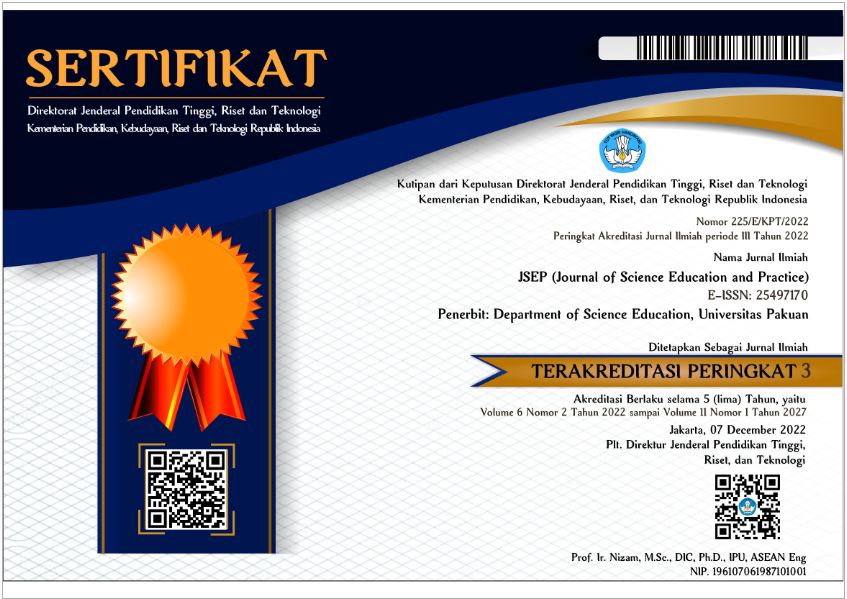ADDITIONAL MENU
UTAUT2 MODEL EVALUATION OF ACCEPTANCE WEB-BASED MULTIMODALITY LEARNING MEDIA
Abstract
In carrying out learning, teachers need a learning media. Along with advances in technology, teachers are required to be able to use technology-based learning media in learning. The purpose of this study is to determine the factors that influence the acceptability of web-based multimodality learning models in elementary school teachers using the Unified Theory of Acceptance and Use of Technology 2 (UTAUT2) model. The method used in this study is a quantitative method with a survey method using a questionnaire. Data processing was carried out using the PLS-SEM analysis technique. The research data was obtained from distributing questionnaires to 100 elementary school teachers. The results of this study indicate that the factors that influence teacher acceptance of web-based multimodality learning media are behavior intention, use behavior, performance expectancy, effort expectancy. ), social influence, facilitating conditions, hedonic motivation, price values, and habits. Based on the value of R Square, this web-based multimodality learning model is good for use in teaching in elementary schools.
Keywords
References
Abdullah, P. M. (2015). Living in the world that is fit for habitation : CCI’s ecumenical and religious relationships. In Aswaja Pressindo.
Adiyanta, F. C. S. (2019). Hukum dan Studi Penelitian Empiris: Penggunaan Metode Survey sebagai Instrumen Penelitian Hukum Empiris. Administrative Law and Governance Journal, 2(4), 697–709. https://doi.org/10.14710/alj.v2i4.697-709
Ainul Bashir, N. A. (2020). Penerapan Model UTAUT 2 Untuk Mengetahui Faktor-Faktor Yang Memengaruhi Penggunaan SIORTU. Elinvo (Electronics, Informatics, and Vocational Education), 5(1), 42–51. https://doi.org/10.21831/elinvo.v5i1.30636
Andreas, C. (2012). UTAUT and UTAUT 2: A Review and Agenda for Future Research. The Winners, 13(2), 106–114.
Andrianto, A. (2020). Faktor Yang Mempengaruhi Behavior Intention Untuk Penggunaan Aplikasi Dompet Digital Menggunakan Model Utaut2. Jurnal Ilmiah Ekonomi Bisnis, 25(2), 111–122. https://doi.org/10.35760/eb.2020.v25i2.2412
Budiarsi, S. Y. (2020). Pendampingan Pengenalan Program SEM-PLS Pada Fakultas Ekonomi Universitas Merdeka Surabaya. Jurnal Abdimas PeKA, 3(2), 126–134.
Haris, C. A., WA, B. S., & Nasiri, A. (2019). Penerapan Model Utaut2 Untuk Mengevaluasi Aplikasi Ruang Guru. Jurnal Teknologi Informasi, 3(2), 192. https://doi.org/10.36294/jurti.v3i2.1085
Januarisman, E., & Ghufron, A. (2016). Pengembangan Media Pembelajaran Berbasis Web Mata Pelajaran Ilmu Pengetahuan Alam Untuk Siswa Kelas Vii. Jurnal Inovasi Teknologi Pendidikan, 3(2), 166. https://doi.org/10.21831/jitp.v3i2.8019
Jennah, R. (2009). Media Pembelajaran. In Media Pembelajaran (1st ed.). Anatasari Press.
Lawanto, O. (2000). PEMBELAJARAN BERBASIS WEB SEBAGAI METODA KOMPLEMEN KEGIATAN PENDIDIKAN DAN PELATIHAN. Unitas, 9(1), 44–58.
Rahardi, R. K. (2022). Multimodalitas sebagai Perspektif Baru Pembelajaran Pragmatik Edukasional: Persepsi Urgensi Inklusinya (Multimodality as a New Perspective of Educational
Pragmatic Learning: Perception of the Urgency of Inclusion). Indonesian Language Education and Literature, 7(2), 449. https://doi.org/10.24235/ileal.v7i2.10018
Ramadloni, S. (2022). Pemanfaatan Laman BIPA Daring dalam Konteks Multimodalitas bagi Pemelajar BIPA. Madah: Jurnal Bahasa Dan Sastra, 13(1), 80–90. https://doi.org/10.31503/madah.v13i1.431
Riyanti, A. (2018). SEM-PLS UNTUK ANALISIS STRUKTUR KEMISKINAN. 8(1), 46–55.
Setianingtias, R., Baiquni, M., & Kurniawan, A. (2019). Pemodelan Indikator Tujuan Pembangunan Berkelanjutan Di Indonesia. Jurnal Ekonomi Pembangunan, 27(2), 61–74. https://doi.org/10.14203/jep.27.2.2019.61-74
DOI: 10.33751/jsep.v7i2.7969
 Abstract views : 278
Abstract views : 278
Refbacks
- There are currently no refbacks.
Copyright (c) 2023 JSEP (Journal of Science Education and Practice)

This work is licensed under a Creative Commons Attribution 4.0 International License.












